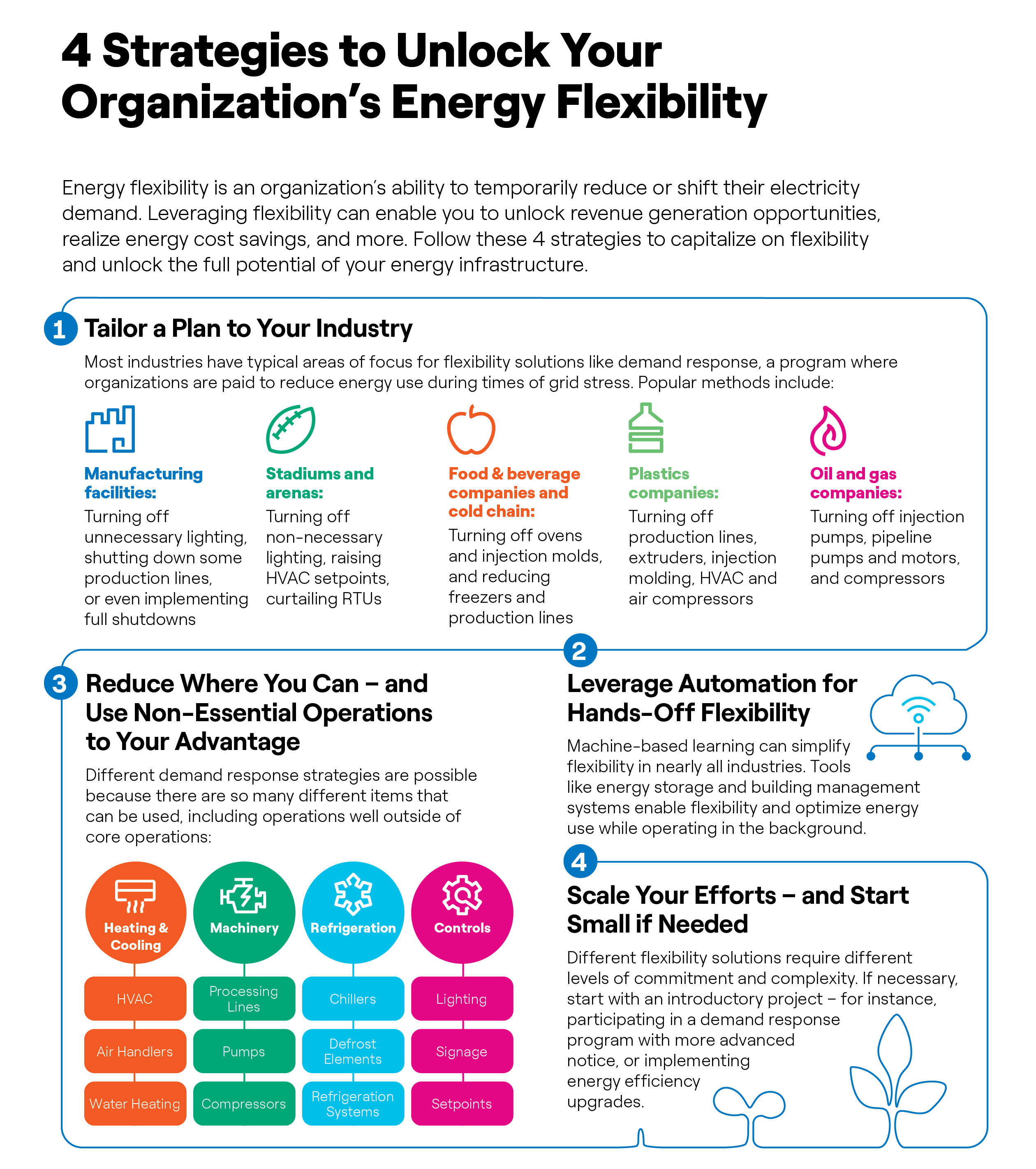Profiting from energy flexibility
Download our eBook to find out how to unlock the revenue potential in your energy infrastructure – and where you may already have that flexibility in your organization.
06 08, 2023
{{ content.description }}
Energy flexibility should be the pillar of any successful energy strategy. As grid operators and utilities come to value it more and more, energy flexibility becomes a lucrative way for organizations to earn new revenue and reduce their energy bills if deployed strategically. Not only that, leveraging flexibility doesn’t have to be difficult or disruptive to your operations.
Perhaps your organization is interested in the earnings available through flexible energy use, but up until now you have hesitated to move forward with these projects. Many organizations may initially think these payments can only come with major disruptions to operations. And since those operations make up their core, day-to-day business and the source of their revenue, there is no reason to endanger that revenue with interruptions.
But because energy flexibility comes in different forms, you can tailor a unique plan that works with your specific energy strategy and energy infrastructure. There are many ways to leverage flexibility to unlock revenue generation opportunities or realize energy cost savings – and you can accomplish this with minimal disruption to your operations.
Use our infographic below to explore strategies to unlock energy flexibility, and then read on for a more detailed dive into these strategies. You can also download a PDF copy for you to easily have on-hand as you develop your energy flexibility strategy.

In the decades-long history of demand response, it’s fair to say that organizations in every industry and sector have participated in the program. Experienced partners that have created energy reduction plans for organizations to participate in demand response will have experience with your organization’s sector, and they know the best way to tailor your demand response strategy to your needs and goals.
Most industries have typical areas of focus for their demand response strategy. A few popular methods they leverage for demand response participation include:
Organizations often quickly find they have more flexibility than they realized. One of our customers, for instance, told us that “because this involves the major piece of equipment for [our facility’s] production, our leadership team needed assurance that we wouldn’t be putting our facilities at risk. As soon as we implemented a plan to operate safely and without an impact on quality, and we achieved the energy savings, [our leadership team] realized the benefit.” Learn more by reading the case study.
Are you looking for ways to maximize demand response performance, improve operation reliability, or just make managing your energy strategy easier? Modern machine-based learning can facilitate and simplify flexibility in nearly all industries – so you can focus on your day-to-day operations, not manual energy management. Tools like energy storage and building management systems, especially, can enable flexibility while operating in the background, whether by shifting energy usage or by simplifying demand response participation. A cloud-based energy management platform can automate decision-making using system-wide analytics, interconnecting market prices, office systems, and grid-tied renewables.
To participate in demand response, there is a huge list of possible assets you can use in your curtailment strategy. Many of these assets may not be essential to the day-to-day operations of your facility. Some organizations shut down as many systems as they can to maximize their earnings, while others may prefer to focus on reducing energy use while operating as normally as possible. It really depends on your energy strategy and where you want to focus.
Different strategies are possible because there are so many different items that can be part of a curtailment strategy – examples of the equipment and applications that you can curtail include:
Different flexibility solutions require different levels of commitment and complexity. Beginning with an introductory project – for instance, participating in a demand response program with more advanced notice, or implementing energy efficiency upgrades – can not only ensure minimal disruption, but it can demonstrate the ROI in continuing to pursue these options.
One of our demand response customers noted that their first demand response site served, in many ways, as proof of concept – company leadership initially hesitated to enroll multiple facilities in demand response. But after the first several payments for their original site, they asked, “What other facilities can we sign up?”
These are just a few of the many possible strategies that allow you to unlock flexibility in your organization’s energy infrastructure. There are countless paths to finding and using flexibility to optimize your energy strategy, earn new revenue, and reduce energy spend. Enel North America has been helping organizations leverage flexibility for decades now, by implementing solutions like demand response and solar + storage. We’ve worked across a wide range of industries in North America and globally, helping organizations tailor a strategy to their specific needs to maximize their flexibility with minimal disruption to their operations.
To learn more about energy flexibility, read our eBook “Profiting From Energy Flexibility.” And to find out how you can unlock the full potential of your energy infrastructure, contact Enel North America.